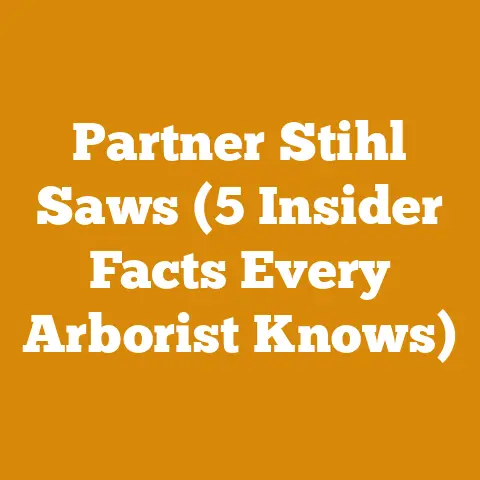Cooking with a Wood Burning Stove (Rustic Heat Cooking Tips)
Ever dreamed of stepping back in time, embracing the warmth of a crackling fire, and creating culinary masterpieces that taste like they were kissed by the flames themselves?
If so, you’re likely drawn to the allure of cooking with a wood-burning stove.
It’s more than just a method; it’s an art, a connection to simpler times, and a way to infuse your food with a depth of flavor you simply can’t achieve with modern appliances.
Embracing the Rustic Charm: Why Cook with Wood?
Why bother with the extra effort of cooking with wood when we have the convenience of gas and electric stoves?
The answer lies in the unique benefits that wood-fired cooking offers:
- Unmatched Flavor: Wood smoke imparts a distinct, smoky flavor to food that is simply irresistible.
The type of wood you use influences the flavor profile, adding layers of complexity to your dishes. - Even Heat Distribution: Wood-burning stoves, when properly managed, provide consistent and even heat distribution, ideal for baking, roasting, and slow-cooking.
- Sustainable Cooking: Using sustainably sourced wood can be an environmentally friendly way to cook, reducing your reliance on fossil fuels.
- Off-Grid Preparedness: In the event of a power outage, a wood-burning stove becomes an invaluable cooking appliance, ensuring you can still prepare meals for your family.
- A Culinary Adventure: Cooking with wood is a hands-on, engaging experience that connects you to the origins of food preparation.
It’s a chance to slow down, appreciate the process, and create memorable meals.
My Own Wood-Fired Awakening
My journey into wood-fired cooking began with a simple desire to reconnect with nature.
I grew up in a rural area, where the smell of wood smoke was a constant companion.
My grandfather was a logger, and I spent countless hours watching him fell trees, split wood, and tend to the wood-burning stove in his cabin.
It was more than just a way to heat the space; it was the heart of the home, the source of warmth, and the center of countless family meals.
As I got older, I became fascinated by the idea of using wood-fired heat to cook.
I started experimenting with a small outdoor oven, learning through trial and error how to control the temperature, manage the smoke, and create delicious meals.
Over time, I honed my skills and developed a deep appreciation for the art of wood-fired cooking.
Now, I have a wood-fired oven in my backyard and a wood-burning cookstove in my kitchen.
I use them regularly to bake bread, roast meats, cook pizzas, and prepare countless other dishes.
It’s a labor of love, but the results are always worth the effort.
Fueling the Fire: Choosing the Right Wood
The type of wood you use significantly impacts the flavor of your food and the overall cooking experience.
Here’s a breakdown of some popular wood choices and their characteristics:
- Hardwoods: These are dense, slow-burning woods that produce a consistent heat and impart a mild, smoky flavor.
- Oak: A classic choice for smoking and grilling, oak offers a strong, smoky flavor that pairs well with beef, pork, and game.
- Maple: A milder, sweeter flavor that’s ideal for poultry, fish, and vegetables.
- Hickory: A strong, bacon-like flavor that’s perfect for smoking ribs, bacon, and other fatty meats.
- Fruitwoods: These woods offer a delicate, fruity flavor that complements lighter meats and desserts.
- Apple: Sweet and mild, applewood is excellent for pork, poultry, and cheese.
- Cherry: Slightly sweet and tart, cherry wood adds a beautiful color to smoked meats.
- Pecan: Nutty and mild, pecan wood is a versatile choice for a variety of dishes.
- Softwoods: These woods burn quickly and produce a lot of smoke, but they can also impart a resinous flavor that’s not always desirable.
- Pine: Avoid using pine for cooking, as it contains resins that can create a bitter, unpleasant taste.
- Cedar: While cedar planks are sometimes used for grilling salmon, it’s generally not recommended to burn cedar for cooking, as it can produce a strong, overpowering flavor.
My Wood Selection Strategy: A Blend of Art and Science
Over the years, I’ve developed a wood selection strategy that combines my personal preferences with the specific requirements of each dish.
For example, when I’m smoking ribs, I like to use a combination of oak and hickory to create a complex, smoky flavor.
For baking bread, I prefer maple or applewood to impart a subtle sweetness.
I also pay close attention to the moisture content of the wood.
Seasoned wood, which has been dried for at least six months, burns more efficiently and produces less smoke than green wood.
I aim for a moisture content of around 20% for optimal burning.
Data Point: According to a study by the University of Tennessee, seasoned hardwood burns approximately 40% more efficiently than green hardwood.
Taming the Flames: Mastering Temperature Control
One of the biggest challenges of cooking with a wood-burning stove is mastering temperature control.
Unlike gas or electric stoves, wood-fired heat is not instantaneous.
It takes time to build a fire, reach the desired temperature, and maintain it consistently.
Here are some tips for taming the flames:
- Start Small: Begin with a small fire and gradually add more wood as needed to reach the desired temperature.
- Use a Thermometer: Invest in a good quality oven thermometer to monitor the temperature inside your stove.
- Control Airflow: Adjust the dampers or vents on your stove to control the airflow, which affects the rate of burning and the temperature of the fire.
- Learn Your Stove: Every wood-burning stove is different.
Take the time to experiment and learn how your stove responds to different types of wood, airflow settings, and firing techniques. - Be Patient: It takes time to master temperature control.
Don’t get discouraged if you don’t get it right away.
Keep practicing, and you’ll eventually develop a feel for it.
My Temperature Control Secrets: A Story of Persistence
I remember one particularly frustrating experience when I was trying to bake a pizza in my wood-fired oven.
I had built a roaring fire, but the oven temperature was too high.
I tried closing the dampers to reduce the airflow, but the temperature just kept climbing.
Eventually, the pizza crust burned to a crisp, and I had to throw it away.
I was ready to give up, but I decided to try again.
This time, I started with a smaller fire and gradually added more wood as needed.
I also paid closer attention to the airflow, making small adjustments as the temperature fluctuated.
After a few more attempts, I finally managed to bake a perfect pizza with a crispy crust and a bubbly, golden-brown topping.
The key, I realized, was patience and persistence.
It takes time to learn how to control the temperature of a wood-burning stove, but the rewards are well worth the effort.
From Firewood to Feast: Essential Wood Processing Techniques
Before you can start cooking with wood, you need to process it into a usable form.
This involves felling trees (if you have access to them), splitting the wood into manageable pieces, and seasoning it properly.
Felling Trees: A Respectful Approach
If you plan to fell your own trees, it’s crucial to do so safely and responsibly.
Here are some essential tips:
- Assess the Situation: Before you start cutting, carefully assess the tree, its surroundings, and the potential hazards.
- Wear Protective Gear: Always wear a hard hat, eye protection, hearing protection, and sturdy boots.
- Use the Right Tools: Choose a chainsaw that’s appropriate for the size of the tree you’re felling.
- Learn Proper Techniques: Take a chainsaw safety course to learn the proper techniques for felling trees safely and efficiently.
- Respect the Environment: Avoid damaging surrounding trees and vegetation, and clean up any debris after you’re finished.
Case Study: A study by the National Institute for Occupational Safety and Health (NIOSH) found that chainsaw-related injuries are most common among inexperienced users.
Taking a chainsaw safety course can significantly reduce your risk of injury.
Splitting Wood: A Blend of Strength and Skill
Splitting wood can be a physically demanding task, but it’s also a great way to get some exercise.
Here are some tips for splitting wood safely and efficiently:
- Choose the Right Tools: Use a splitting axe or maul that’s appropriate for the size and type of wood you’re splitting.
- Use a Splitting Block: Place the wood on a sturdy splitting block to provide a stable surface.
- Stand with Your Feet Shoulder-Width Apart: This will give you a stable base and prevent you from losing your balance.
- Swing with Your Whole Body: Use your legs, core, and arms to generate power.
- Aim for the Center: Strike the wood in the center to split it cleanly.
- Wear Gloves: Protect your hands from splinters and blisters.
Seasoning Wood: Patience is Key
Seasoning wood is the process of drying it to reduce its moisture content.
This is essential for efficient burning and minimizing smoke.
- Split the Wood: Splitting the wood exposes more surface area, allowing it to dry faster.
- Stack the Wood: Stack the wood in a well-ventilated area, off the ground, and covered with a tarp to protect it from rain and snow.
- Allow Time to Dry: The amount of time it takes to season wood depends on the type of wood, the climate, and the size of the pieces.
Generally, hardwoods should be seasoned for at least six months, while softwoods can be seasoned in as little as three months.
Data Point: A study by the University of Maine found that properly seasoned wood can produce up to 25% more heat than green wood.
My Wood Processing Philosophy: From Forest to Fire
I approach wood processing with a deep respect for the environment and a commitment to sustainability.
I only fell trees that are dead, dying, or posing a safety hazard.
I also make sure to replant trees to ensure the long-term health of the forest.
I view wood processing as a form of exercise and a way to connect with nature.
I enjoy the physical labor of felling trees, splitting wood, and stacking it neatly in my woodpile.
It’s a satisfying feeling to know that I’m providing my family with a sustainable source of heat and fuel for cooking.
The Heart of the Kitchen: Wood-Burning Stove Types and Features
Wood-burning cookstoves come in a variety of styles and sizes, each with its own unique features and benefits.
Here are some common types:
- Traditional Cookstoves: These stoves are designed primarily for cooking, with a large cooktop and an oven.
- Combination Stoves: These stoves combine cooking and heating capabilities, with a cooktop, oven, and a firebox that can be used to heat the surrounding space.
- Outdoor Ovens: These ovens are designed for outdoor cooking, typically for baking pizzas, bread, and other dishes.
Key Features to Consider
When choosing a wood-burning cookstove, consider the following features:
- Size: Choose a stove that’s appropriate for the size of your kitchen and your cooking needs.
- Cooktop: Look for a cooktop with a large, flat surface that provides even heat distribution.
- Oven: Consider the size and temperature range of the oven.
- Firebox: Choose a firebox that’s easy to load and clean.
- Airflow Control: Look for a stove with adjustable dampers or vents to control the airflow.
- Efficiency: Consider the stove’s efficiency rating, which indicates how much heat it produces per unit of wood burned.
- Safety Features: Look for a stove with safety features such as a spark arrestor and a door latch.
My Stove Selection Story: A Quest for the Perfect Fit
When I decided to install a wood-burning cookstove in my kitchen, I spent months researching different models and features.
I wanted a stove that was both functional and aesthetically pleasing, one that would complement the rustic charm of my home.
I eventually settled on a traditional cookstove with a large cooktop, a spacious oven, and a beautiful enamel finish.
It was an investment, but it’s been worth every penny.
I use it every day to cook meals for my family, and it’s become the heart of my kitchen.
Recipes for Rustic Heat: From Simple to Sublime
Now that you have a wood-burning stove and a supply of seasoned wood, it’s time to start cooking!
Here are some recipes to get you started:
- Wood-Fired Pizza: A classic dish that’s perfect for showcasing the smoky flavor of wood-fired cooking.
- Roasted Chicken: Roasting a chicken in a wood-burning oven results in incredibly juicy and flavorful meat.
- Baked Bread: The even heat of a wood-burning oven is ideal for baking crusty, artisan-style bread.
- Grilled Vegetables: Grilling vegetables over wood fire imparts a smoky char that’s simply delicious.
- Slow-Cooked Stew: A wood-burning stove is perfect for slow-cooking stews and soups, allowing the flavors to meld together beautifully.
My Signature Wood-Fired Recipe: Smoked Brisket
One of my favorite dishes to cook on my wood-burning stove is smoked brisket.
It’s a labor of love, but the results are always worth the effort.
Here’s my recipe:
Ingredients:
- 1 (12-14 pound) beef brisket
- 1/4 cup kosher salt
- 1/4 cup black pepper
- 2 tablespoons garlic powder
- 2 tablespoons onion powder
- Wood for smoking (oak and hickory)
Instructions:
- Trim the excess fat from the brisket, leaving about 1/4 inch of fat on top.
- In a small bowl, combine the salt, pepper, garlic powder, and onion powder.
- Rub the spice mixture all over the brisket.
- Wrap the brisket in plastic wrap and refrigerate for at least 12 hours, or up to 24 hours.
- Prepare your wood-burning stove for smoking, aiming for a temperature of 225-250°F.
- Add wood to the fire as needed to maintain the temperature and generate smoke.
- Place the brisket on the smoker grate, fat-side up.
- Smoke the brisket for 12-14 hours, or until it reaches an internal temperature of 203°F.
- Wrap the brisket in butcher paper and continue smoking for another 2-3 hours, or until it’s probe-tender.
- Remove the brisket from the smoker and let it rest for at least 1 hour before slicing.
- Slice the brisket against the grain and serve.
Safety First: Best Practices for Wood-Burning Stoves
Wood-burning stoves can be a safe and efficient way to cook and heat your home, but it’s essential to follow safety precautions to prevent fires and other hazards.
- Install a Smoke Detector and Carbon Monoxide Detector: These detectors will alert you to the presence of smoke or carbon monoxide, which can be deadly.
- Have Your Stove Professionally Installed: Ensure that your stove is installed by a qualified professional who can ensure that it’s properly vented and meets all safety codes.
- Clean Your Chimney Regularly: Creosote, a flammable substance that builds up in chimneys, can cause chimney fires.
Have your chimney cleaned at least once a year, or more often if you use your stove frequently. - Store Wood Safely: Store wood away from the stove and other heat sources to prevent it from catching fire.
- Never Leave a Fire Unattended: Always supervise a fire and never leave it unattended.
- Keep a Fire Extinguisher Nearby: Keep a fire extinguisher nearby in case of a fire.
- Educate Your Family: Teach your family about wood-burning stove safety.
My Safety Pledge: Protecting My Home and Family
I take wood-burning stove safety very seriously.
I have smoke detectors and carbon monoxide detectors installed throughout my home, and I have my chimney cleaned every year.
I also store my wood in a safe location away from the stove.
By following these simple precautions, you can enjoy the warmth and flavor of wood-fired cooking without putting your home or family at risk.
Troubleshooting Common Challenges: A Practical Guide
Even with the best preparation, you may encounter challenges when cooking with a wood-burning stove.
Here are some common problems and solutions:
- Difficulty Starting a Fire:
- Problem: The wood is too wet, the airflow is restricted, or the kindling is not catching.
- Solution: Use dry, seasoned wood, ensure adequate airflow by opening the dampers, and use plenty of dry kindling.
- Uneven Heat Distribution:
- Problem: The fire is not burning evenly, the stove is not level, or the oven is not properly insulated.
- Solution: Rake the coals to distribute the heat evenly, ensure the stove is level, and check the oven insulation for any gaps or damage.
- Excessive Smoke:
- Problem: The wood is too wet, the chimney is blocked, or the fire is not burning efficiently.
- Solution: Use dry, seasoned wood, check the chimney for obstructions, and ensure adequate airflow to promote efficient burning.
- Temperature Fluctuations:
- Problem: The wood is burning too quickly or too slowly, the airflow is not properly adjusted, or the stove is not properly insulated.
- Solution: Use a variety of wood sizes to control the burn rate, adjust the dampers to regulate airflow, and check the stove insulation for any gaps or damage.
- Food Burning:
- Problem: The oven temperature is too high, the food is too close to the heat source, or the cooking time is too long.
- Solution: Lower the oven temperature, move the food further away from the heat source, and reduce the cooking time.
My Troubleshooting Tales: Learning from Mistakes
I’ve certainly had my share of troubleshooting experiences with my wood-burning stove.
I remember one time when I was trying to bake a cake, and the bottom burned to a crisp while the top was still raw.
I was so frustrated, but I didn’t give up.
I realized that the oven temperature was too high, so I lowered it and moved the cake to a higher rack.
I also reduced the cooking time.
The next time I baked the cake, it came out perfectly.
The key to troubleshooting is to be patient, observant, and willing to experiment.
Don’t be afraid to make mistakes, and learn from them.
The Future of Rustic Heat: Innovations and Trends
While wood-burning stoves have been around for centuries, they continue to evolve with new innovations and trends.
- EPA-Certified Stoves: These stoves are designed to burn more efficiently and produce less pollution, meeting strict environmental standards.
- Hybrid Stoves: These stoves combine wood-burning with other fuel sources, such as gas or electricity, for greater convenience and flexibility.
- Smart Stoves: These stoves feature electronic controls and sensors that automatically regulate the temperature and airflow, making them easier to use and more efficient.
- Sustainable Wood Sourcing: There’s a growing emphasis on sourcing wood from sustainably managed forests, ensuring the long-term health of our forests and reducing our environmental impact.
My Vision for Rustic Heat: A Sustainable and Flavorful Future
I believe that wood-burning stoves have a bright future.
As people become more interested in sustainable living and authentic culinary experiences, the demand for wood-fired cooking will continue to grow.
I envision a future where wood-burning stoves are even more efficient, user-friendly, and environmentally friendly.
I also believe that there will be a greater emphasis on sourcing wood from sustainably managed forests and using it responsibly.
Conclusion: Embracing the Art of Wood-Fired Cooking
Cooking with a wood-burning stove is more than just a method of food preparation; it’s an art, a connection to nature, and a way to create unforgettable culinary experiences.
It requires patience, skill, and a willingness to learn, but the rewards are well worth the effort.






